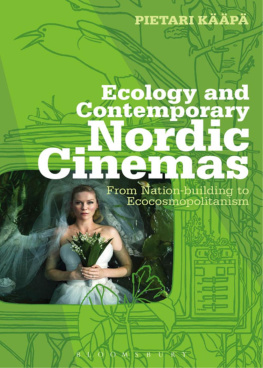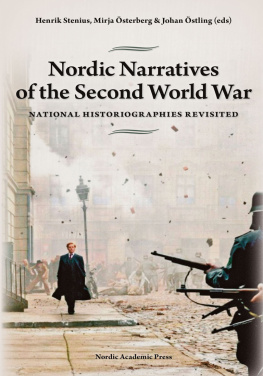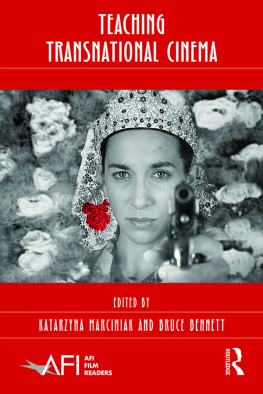
Topics and Issues in National Cinema
VOLUME 2
Ecology and Contemporary Nordic Cinemas
Series Editor: Armida de la Garza, University College Cork, Ireland
Editorial Board:
Mette Hjort, Chair Professor and Head, Visual Studies, Lingnan University, Hong Kong
Lcia Nagib, Centenary Chair in World Cinemas, University of Leeds, UK
Chris Berry, Professor of Film and Television Studies and Co-Director of the Goldsmiths Leverhulme Media Research Centre, UK
Sarah Street, Professor of Film and Foundation Chair of Drama, Bristol University, UK
Jeanette Hoorn, Professor of Visual Cultures, School of Culture and Communication, Faculty of Arts, University of Melbourne, Australia
Shohini Chaudhuri, Director of the Centre for Film Studies, University of Essex, UK
Other Titles in the Series:
Volume 1: Revolution and Rebellion in Mexican Film
I would like to thank, first of all, Armida De La Garza, the editor of Issues and Topics in National Cinema. Her guidance and critical feedback have been invaluable throughout the project.
The editorial team at Continuum/Bloomsbury has provided sterling support and enabled the timely completion of the project.
Finally, I would like to offer my sincerest gratitude to the anonymous peer reviewers whose insightful and pervasive comments were significant for the final shape and flow of my arguments.
As ever, this book is dedicated to the one and only Yan.
Contents
infrastructure of countries such as Norway and Finland relies on resources such as oil and nuclear power. These contradictions evident not only in environmental policy, but in cultural reflections of this policy are at the centre of this book.
Taking a more media studies focused approach to environmental communications, Sean Cubitts Ecomedia (2005) and Sidney Dobrin and Sean Moreys Ecosee (2007) spread out to explore diverse philosophical and material considerations, including the ways media representations interact with the world they represent as well as the material footprint film productions leave on the environment which they represent. While much of this work focuses on mainstream media, experimental film production has received attention from Scott McDonald (2004) as well as articles in Paula Willoquet-Maricondis Framing the World (2010). Willoquet-Maricondis collection expands the scope of existing works, firmly planted in criticism of Western modes of representation by including articles on Japanese cinema, among others. Similar directions are taken by Sheldon Lu and Jiayan Mi and their collection on Chinese ecocinema (2009) provides an important predecessor for this collection as it explores the transnational dimensions of Chinese cinema, contributing much to national and ecocinema studies. Finally, Monani, Rust and Cubitts Ecocinema Theory and Practice (2012) is a more recent and perhaps the most wide-ranging of ecocinema collections to date, providing many key interventions in the field as well as consolidating its importance further. It, and many of the other works mentioned above, are explored throughout this work.
Defining ecocinema
What exactly is ecocinema, then? Lu and Mi provide a suggestive delineation that conceptualizes it as a critical grid, an interpretative strategy based on questioning the conventional ways in which environmentalism and nature are represented in cultural production. Furthermore, it is a description of a conscious film practice among a range of different artists and producers. Ecocinema is thus both a way to study films and an ethical-environmental approach to the production practices of film texts. According to Mi and Lu, it involves the study of the production and reproduction of life, the relationship between the human body and the ecosystem, and the controlling and administering of the human body in modern capitalist and socialist regimes (Lu and Mi 2009: 2).
An ecological understanding of film culture does not have to thus only concern films that explicitly engage environmentalist politics or work with an aesthetic appreciation of nature. To these ends, we are not focused on compiling a list of what David Ingram (2004) has called environmental films. These are texts that leave room for environmental considerations, but which subjugate any sense of environmentalism to increasing the films cultural relevance. In terms of wider policy, environmental rhetoric is central to arguments concerning activities like sustainability drives, green energy production, environmental policy and nature conservation. These are all valuable aspects of providing, at least, a semblance of sense to the contemporary anthropocentric world, where human-led exploitation of resources and harvesting of the environment form the basic principles of conceptualizing of humanitys role in the ecosystem. But such environmental perspectives only reconceptualize nature as a resource for human consumption, or as Willoquet-Maricondi (2010) suggests in relation to film studies, environmental films are content with showing nature but do not do much with it beyond establishing human-centric narrative concerns.
Ecological approaches, in contrast, call for a more thorough rethinking of this relationship, including a fundamental reorganization of contemporary political and cultural paradigms. For me, to interpret and work only with such limited environmental evocations serves to strengthen the notion of cinema as part of a wider social project focused on human self-realization. Rather, what I am interested in is to move the study of these environmental productions to an ecocritical level, and interrogate the relationship between humanity and the natural environment by incorporating critical work from the burgeoning field of ecocinema studies. As scholars in literary ecocriticism repeatedly point out (see Goodbody and Rigby 2011, for some of these perspectives), ecocinema studies must question the role of humanity as an embedded part of the ecosystem and make a distinct clarification between environmentalism and ecocriticism. As media theorist Matthew Fuller suggests, interconnectivity and the breaching of culturally constructed boundaries is an integral part of ecocritical explorations of cultural production, an approach that distinguishes itself from more environmentalist concerns:
Echoing the differences in life sciences and various Green political movements, environmentalism possesses a sustaining vision of the human and wants to make the world safe for it. Such environmentalism also often suggests a state of equilibrium Ecologists focus more on dynamic systems in which any one part is always multiply connected, acting by virtue of these connections and always variable, so that it can be regarded as a pattern rather than simply an object.
Fuller 2005: 4
For Finnish sociologist Timo Rikknen (2011), this is a distinction between an anthropocentric and an ecocentric worldview. Anthropocentricism indicates a way of thinking that places human experience at the centre of all logic and consideration over other parts of the ecosystem. Such perspectives consider the welfare of the human kind as the key principle for planetary development of interconnected parts of the ecosystem. By contrast, ecocentrism approaches humanity as part of the diversity of the ecosystem, on par with all the other organisms and processes that comprise its complex structures. The concept of the more than human world indicates the basic tenet of an ecocentric worldview, where humanity is just one part of a much more complex network of intersecting, inter-reliant existence. How do such ecocentric perspectives work in cinema then?
Next page






